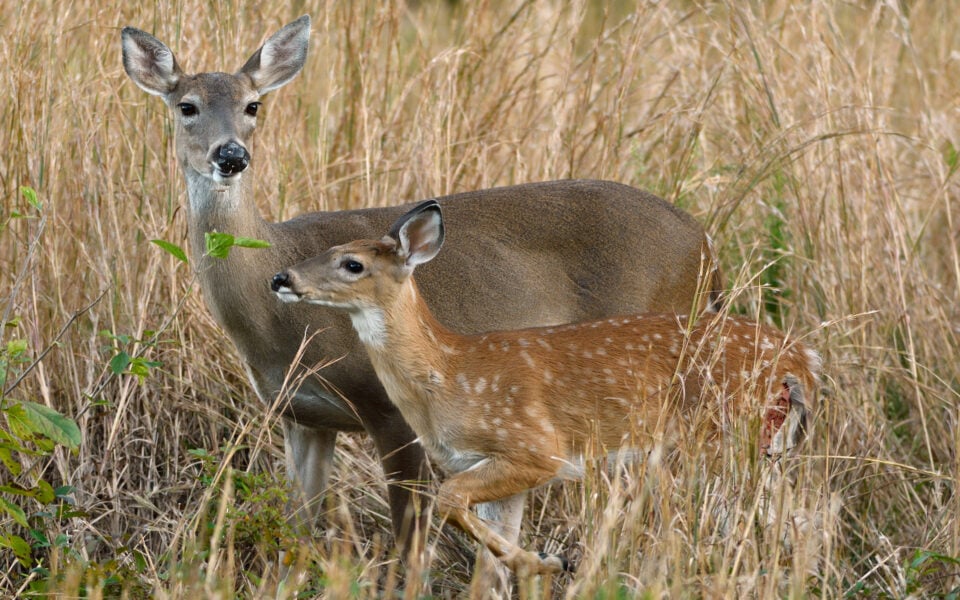There’s a whitetail doe whose fawning area is within 200 yards of our back porch. Deer live in close proximity because we manage the area with prescribed burns and mowing for secure bedding and fawning cover with nearby native and cultivated forage. Maybelline, who is nicknamed for her thick, black eyelashes, has birthed single or twin fawns there for the past five years. I’m blessed to photograph and follow their progress during late summer and early fall.
On October 26, 2018 Maybelline and her buck fawn emerged from native grass cover in the warm afternoon light to feed in a viewing lane. The fawn was sticking very close to his mother’s side as they browsed. I soon realized why. A large open wound on the fawn’s left hindquarter and less serious ones on its neck and behind the right shoulder left no doubt it had nearly become a predator’s meal.
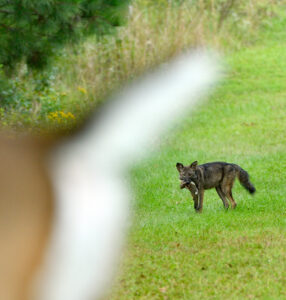
Tes Jolly
Our farm is located in central Alabama so more than likely a coyote(s) was responsible for the attack. A female dark-phase coyote came immediately to mind as it’s territory overlapped Maybelline’s core area. I had a unique opportunity to photograph the coyote while photographing several deer including the doe and fawn. On October 13, 2018, the coyote stepped out of cover, jaws clamped on a cottontail, and proceeded to eat it within sight of the deer and my blind. I learned a coyote could devour a full-grown rabbit from mouth to stomach in about 3 minutes!
The following photo series shows the injuries to the fawn that had likely been inflicted by a coyote. The first thought that came to mind was how lucky it had been to survive the attack. The nickname for the fawn was a no brainer. Happily, Lucky’s wounds healed swiftly. The leg scar left him with a unique hair tuft making him identifiable on close inspection.
The event left me with questions on fawn survival. Did Lucky escape on his own or did his mother’s protective instincts help rescue him? Did Maybelline cast furious hoof blows at the predator, aiding in her fawn’s escape? Perhaps, though I’ll never know. Did access to quality food sources help produce a healthier, stronger doe and fawn able to defend and survive the attack? Did excellent escape cover play a part? I believe so. It definitely gave valuable insight on the importance of sound whitetail management practices and their effects on fawn survival that we as gamekeepers can act on.
An Expert’s Findings on Fawn Survival
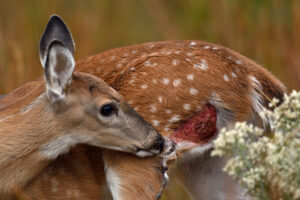
Tes Jolly
Fawn survival during a deer’s first weeks is heavily influenced by several factors – an overall diverse habitat, adequate fawning cover, high quality and abundant forage, and predator numbers. I shared Lucky’s story and photos with Dr. Will Gulsby, Associate Professor of Wildlife Management at the Auburn University School of Forestry and Wildlife Sciences. He has done extensive research on coyote predation on fawns. According to Dr. Gulsby, throughout much of the whitetail’s range, coyotes are the number one fawn predator. Bobcats also take some fawns (but not nearly as many as coyotes), and black bears take quite a few fawns (potentially as many as coyotes), in areas where they are present.
Dr. Gulsby states, “Fawn predation rates vary quite a bit from one area to another. From a regional perspective, reported coyote predation rates on fawns are much higher in the Southeast and over to Texas and Oklahoma than in the northeast and Midwest/upper Midwest. The highest rate reported in the Midwest was in Illinois, where coyotes killed 38% of collared fawns. In the Northeast, the highest rate reported was in Maine, where coyotes killed 28% of collared fawns. However, rates as high as 57% have been reported in Oklahoma and Texas, and the highest rate ever recorded was 62% in South Carolina.”
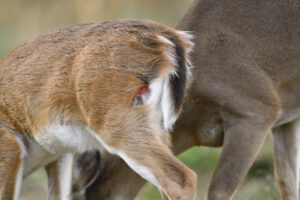
Tes Jolly
“What’s interesting though, is that even within the same state, and sometimes within the same county, coyote predation on fawns varies quite a bit. There are multiple instances of two-fold differences in coyote predation rates within the same state (e.g., 25% vs. 57% on two sites in south Texas and 24% vs. 47% on two sites in SW Georgia). In one of my research projects, we looked at fawn recruitment rates on two several thousand acre properties in the same central Georgia county. On one of the sites, recruitment was half of what it was prior to coyote colonization of the site (around 0.5 fawns/doe recruited per year). Five miles away on the other site, recruitment was as high as ever (0.9 fawns/doe recruited per year). We’re not sure what the causes of variation are, but there are likely several contributing factors,” said Dr. Gulsby.
Dr. Gulsby’s research demonstrates that reducing coyote numbers through trapping can be helpful but it doesn’t always increase fawn survival.
“The problem with trying to reduce coyote numbers in an area relates back to their biology. Namely, they have large home ranges (think 1,000 acres at the small end, several thousand acres at the large end), but some of them have no home range at all. We typically call the former residents and the latter transients. The transients cycle around the landscape, apparently looking for a high quality, vacant, territory. When a resident animal is removed, they quickly detect and fill that gap. That means that coyote populations don’t have to compensate for removal via reproduction, it happens much faster than that! So instead of taking an entire generation (reproductive cycle plus the time it takes the pups to mature) for the population to bounce back, sometimes it happens in days or weeks,” said Dr. Gulsby.

Tes Jolly
He continues, “If you’re going to try to increase fawn survival through coyote trapping, you want to time trapping efforts so that most of the animals are removed right before and during peak fawn drop in an area. It will also need to be done every year. Even when those guidelines are followed, our data show that trapping results in fairly large increases in fawn survival, or recruitment some years, and little to no increase in others, so the overall effect of trapping on fawn survival is modest.”
As mentioned earlier, maintaining habitat diversity is also a factor in fawn survival that may reduce coyote predation on fawns.
Dr. Gulsby said, “Managing a property for a diversity of cover types and age classes might reduce coyote predation on fawns. We used the tracking data for a couple hundred fawns in South Carolina to compare composition of fawn home ranges for surviving vs. coyote depredated fawns. Generally speaking, the more diverse a fawn’s home range, the lower its predation risk. For example, a diverse home range in our study may have been comprised of young pine plantation, bottomland hardwoods, open, burned, mature pine woodlands, and early successional areas like power line right-of-ways. On the opposite end of the spectrum were fawns whose home ranges contained only bottomland hardwood forest. In that study, fawns with the most diverse home ranges were about two-times less likely to be killed by coyotes than those with the least diversity in their home ranges.”
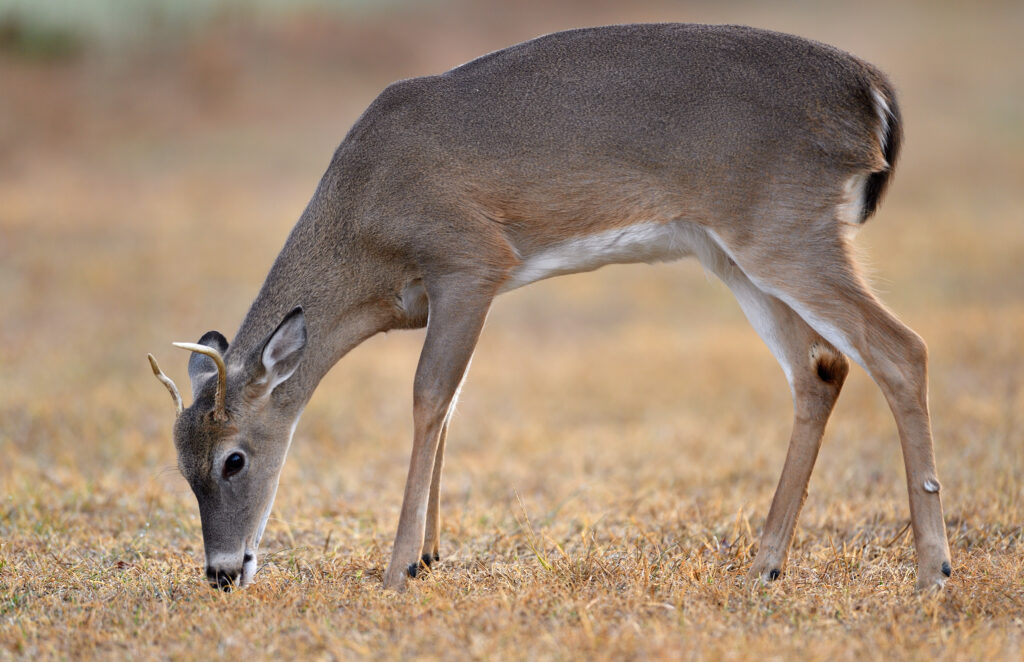
Tes Jolly
Final Thoughts
As gamekeepers it’s imperative we implement a whitetail management plan that includes habitat, nutritional and predator control measures with respect to fawn survival. Optimum conditions give vulnerable fawns the best possible chance to live through the first critical weeks of life. Who knows how many potential trophy class bucks, even Pope &Young or Boone & Crockett class deer, never make it past the spotted fawn stage due to predation or lack of quality habitat and food? Nature can be cruel to those low on the food chain. A young buck named Lucky won the first survival battle and surely learned a valuable lesson that will serve him well as he matures.

